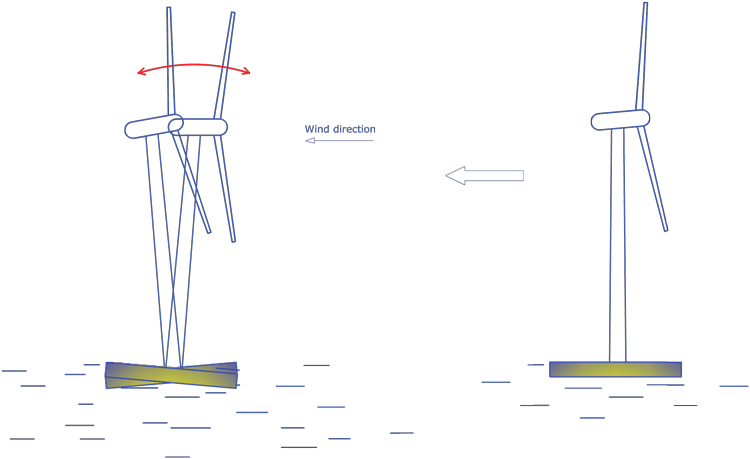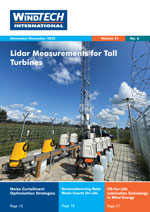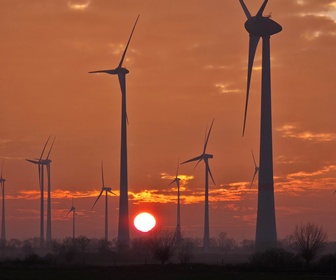 In any complex system with a multipart structure, such as a wind turbine, reducing the number of major components can lead to a reduction in the cost as well as the probability of breakdowns and the associated expenses. Among the major components in a horizontal-axis wind turbine is the yaw system, which any modern large-size wind turbine has. Very old and very small turbines could benefit from a passive system in the form of a wind vane, which was obviously much cheaper than an active yaw system. It would be ideal in a floating wind turbine if the yaw system could be removed, in light of the fact that the floating platform can move/turn and act as a substitute for the yaw system. But is it possible?
In any complex system with a multipart structure, such as a wind turbine, reducing the number of major components can lead to a reduction in the cost as well as the probability of breakdowns and the associated expenses. Among the major components in a horizontal-axis wind turbine is the yaw system, which any modern large-size wind turbine has. Very old and very small turbines could benefit from a passive system in the form of a wind vane, which was obviously much cheaper than an active yaw system. It would be ideal in a floating wind turbine if the yaw system could be removed, in light of the fact that the floating platform can move/turn and act as a substitute for the yaw system. But is it possible?
By Ahmad Hemami, McGill University, Montreal, Canada
A wind turbine is subject to various forces from wind on the rotor and the tower when operating or shut down. Apart from the resultant of these forces and their associated torques that contribute to electricity generation, the rest are transferred to the foundation. The foundation, thus, must be capable of withholding all the forces/torques that ultimately are passed to the ground.
For a floating turbine, not only is there no ground to withstand the turbine force and torques, but the base is also subject to additional forces from the waves and wind. The base must not transfer the effects from the wave and wind to the turbine. Otherwise, the adverse effects lead to poor performance and extra stresses on the turbine parts. For example, the floating base can induce oscillations in the turbine, as shown in figure 1. In this figure the oscillations take place in a plane parallel to the wind direction; however, in whatever direction they might occur, they worsen the turbine performance and are harmful to the turbine structure.
Without waves (a hypothetical scenario) a floating foundation needs to be able to withstand its own weight plus the weight of the turbine it holds. Nonetheless, waves exert significant hydrodynamic forces on floating wind turbines. For the above reasons, the foundations of floating wind turbines must be much larger, so that they suppress, as much as possible, any induced motion due to wind and hydrodynamic forces. This can significantly increase their weight. For example, for a 15 MW turbine (about 600 tonnes), a steel floater can be about 3500 tonnes. This gives a weight ratio of approximately 5.8. A concrete floater is heavier (17,000 tonnes) and for the same turbine weight (600 tonnes), the ratio would be approximately 28.3.
Generally, ocean waves travel in the same direction as the wind that generates them, particularly out at sea. The orientation of a floating structure on the water surface depends on various factors, such as the shape, the weight, the centre of mass position and so on. Thus, even if the wind direction does not change for a long time, this fact makes it rather complicated and difficult to determine the angle between wind direction and the structure (1). Now, if the wind direction changes, the structure ultimately weathervanes into a new direction if there is sufficient time for the change to take place (that is, the new wind direction stays unchanged for a sufficiently long time).
Undoubtedly, the floating structure weight plays an important role in resuming a new orientation. The heavier the structure is, the longer it takes to reorient. This might be too long for a turbine adaptation to the wind direction. As for example, if it takes 5 hours for a platform to assume a new orientation, and during these 5 hours we have 3 changes in wind direction, then we cannot expect any useful result for a wind turbine to rely on the reorientation of its foundation if installed on this platform.
On the other hand, if at a site there is not any significant change in the wind direction during the 24 hours, then one can confidently count on the orientation of the foundation for facing a turbine towards the wind.
There is, however, another important point for a horizontal wind turbine to have yaw motion, and that is turning the turbine out of wind for maintenance and when it is supposed to be shut down. This cannot be done if there is no active yaw motion system.
Recently, a European company, X1 Wind (2), has reported experimental results for using the concept of weathervane for an offshore wind turbine. The turbine used in this case is a Vestas V29, which to today’s standard is very small. Even if the result for such a small turbine is satisfactory, it is very doubtful that it can be scaled up for today’s much larger turbines.
Further reading
(1) A. Yadav, S. Varghese and K. P. Thiagarajan “Parametric Study of Yaw Instability of a Weathervaning Platform”, 16th Australasian Fluid Mechanics Conference, 2007
(2) Weathervaning Downwind Configuration, https://www.x1wind.com/technology/










